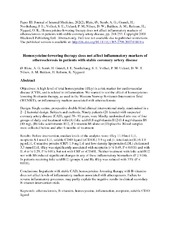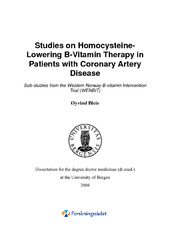| dc.contributor.author | Bleie, Øyvind | en_US |
| dc.date.accessioned | 2009-02-04T15:22:25Z | |
| dc.date.available | 2009-02-04T15:22:25Z | |
| dc.date.issued | 2008-06-06 | eng |
| dc.identifier.isbn | 978-82-308-0580-0 (print version) | en_US |
| dc.identifier.uri | https://hdl.handle.net/1956/3119 | |
| dc.description.abstract | Background: A high plasma level of total homocysteine (tHcy) is a risk factor for cardiovascular disease, and is related to important components of atherosclerosis such as inflammation and endothelial dysfunction. Objectives: To test the effect of homocysteine-lowering B-vitamin therapy on 1) tHcy, and metabolites and determinants of tHcy, 2) inflammatory markers associated with atherosclerosis and 3) coronary endothelial and vascular function. Design: Single centre, double-blind clinical interventional study, randomised in a 2x2 factorial design into daily oral treatment with A) folic acid (0.8 mg)/vitamin B12 (0.4 mg)/vitamin B6 (40 mg), B) folic acid/vitamin B12, C) vitamin B6 alone or D) placebo. For the first two weeks, groups A and B received additional folic acid 5 mg/day. Subjects and methods. Two sub-groups of patients participating in the Western Norway Bvitamin Intervention Trial (WENBIT); Patient group 1: Ninety patients (21 female, aged 38- 80 years) with suspected coronary artery disease (CAD). Blood samples were collected at baseline, after 3 days, 2 weeks, 1, 3, 6 months and one year of B-vitamin intervention. An oral methionine loading test (0.1 g/kg body weight) was done at baseline and after 3 months. Patient group 2: Forty patients (8 female, aged 39-74 years) with CAD. They were examined at baseline, and after 9 and 24 months, coronary blood flow (CBF) was assessed by coronary angiography and Doppler flow-wire measurements during intra-coronary infusion of saline (basal), incremental (0.72 μg/min, 7.2 μg/min and 36.0 μg/min) doses of acetylcholine, 2.4 mg/min adenosine and nitroglycerin. Results: In patient group 1, we documented a reduction of 31% on plasma tHcy and a pronounced reduction of post methionine load (PML) tHcy by folic acid/vitamin B12. Vitamin B6 reduced cystathionine and particularly PML cystathionine. There was a strong inverse relation between PML betaine and PML increase in tHcy, a relation that was abolished by folic acid/vitamin B12 treatment for 3 months. Treatment with folic acid/vitamin B12 or vitamin B6 for 6 months had no effects on levels of neopterin, sCD40L, IL 6 or CRP. During the two years of follow-up of patient group 2, basal CBF and adenosine-stimulated CBF increased among patients treated with folic acid /B12 as opposed to those not receiving folic acid /B12. Conclusions: The doses of folic acid/B12 applied in WENBIT give adequate tHcy lowering effect. Cystathionine may be a useful marker for assessment of the vitamin B6 effect. Plasma betaine is a strong determinant of the PML increase in tHcy in patients not supplemented with B-vitamins which emphasizes the complementary relationship between betaine and folate metabolism. Although we observed improved coronary vascular function after treatment with folic acid/vitamin B12, failure to reverse inflammatory processes associated with atherosclerosis may partly explain the negative results of previous B-vitamin intervention trials among patients with established CVD. | en_US |
| dc.language.iso | eng | eng |
| dc.publisher | The University of Bergen | eng |
| dc.relation.haspart | Paper I: American Journal of Clinical Nutrition 80(3), Bleie, Ø.; Refsum, H.; Ueland, P. M.; Vollset, S. E.; Guttormsen, A. B.; Nexo, E.; Schneede, J.; Nordrehaug, J. E.; Nygard, O., Changes in basal and postmethionine load concentrations of total homocysteine and cystathionine after B vitamin intervention, pp. 641-8. Copyright © 2004 by The American Society for Nutrition. Abstract only. Full-text not available due to publisher restrictions. | en_US |
| dc.relation.haspart | Paper II: Arteriosclerosis, Thrombosis, and Vascular Biology 24(2), Holm, P. I.; Bleie, Ø.; Ueland, P. M.; Lien, E. A.; Refsum, H.; Nordrehaug, J. E.; Nygard, O., Betaine as a Determinant of Postmethionine Load Total Plasma Homocysteine Before and After BVitamin Supplementation, pp. 301-7. Copyright 2004 American Heart Association, Inc. All rights reserved. The published version is available at: <a href="http://dx.doi.org/10.1161/01.ATV.0000114569.54976.31" target ="blank">http://dx.doi.org/10.1161/01.ATV.0000114569.54976.31</a> | en_US |
| dc.relation.haspart | Paper III: Journal of Internal Medicine, 262(2), Bleie, Ø.; Semb, A. G.; Grundt, H.; Nordrehaug, J. E.; Vollset, S. E.; Ueland, P. M; Nilsen, D. W.; Bakken, A. M.; Refsum, H.; Nygard, O. K., Homocysteine-lowering therapy does not affect inflammatory markers of atherosclerosis in patients with stable coronary artery disease, pp. 244-253. Copyright 2009 Blackwell Publishing Ltd. Abstract only. Full-text not available due to publisher restrictions. The published version is available at: <a href="http://dx.doi.org/10.1111/j.1365-2796.2007.01810.x" target ="blank">http://dx.doi.org/10.1111/j.1365-2796.2007.01810.x</a> | en_US |
| dc.relation.haspart | Paper IV: Bleie, Ø.; Strand, E.; Ueland, P. M.; Vollset, S. E.; Refsum, H.; Igland, J.; Nordrehaug, J. E.; Nygård, O., Folic Acid Intervention Increases Coronary Blood Flow in Patients with Stable Coronary Artery Disease. Draft version. | en_US |
| dc.title | Studies on homocysteine-lowering B-vitamin therapy in patients with coronary artery diseas : sub-studies from the Western Norway B-vitamin intervention trial (WENBIT) | en_US |
| dc.type | Doctoral thesis | |
| dc.subject.nsi | VDP::Medisinske Fag: 700::Klinisk medisinske fag: 750::Kardiologi: 771 | nob |




